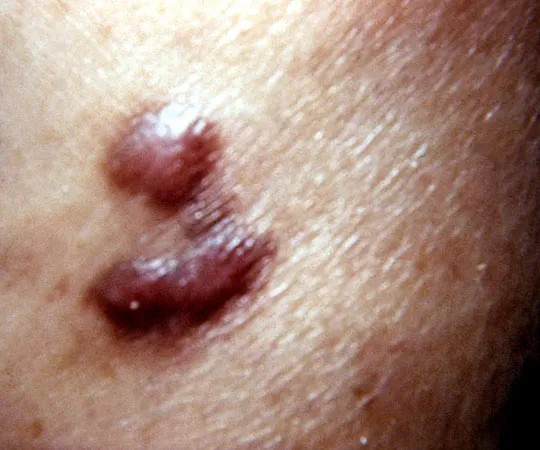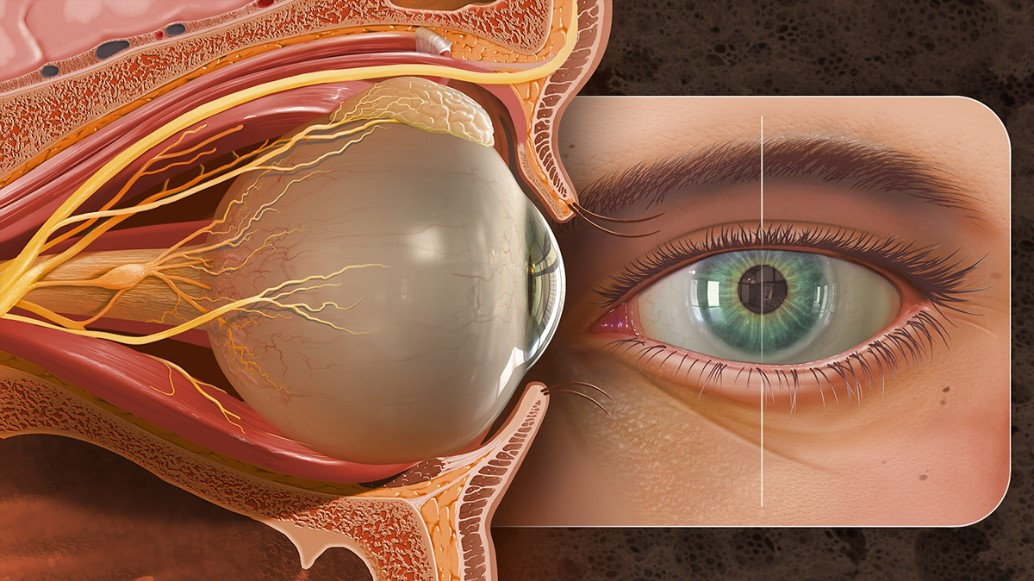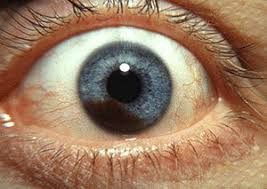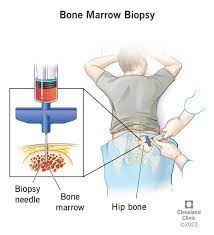Definisi
Sarkoma Kaposi adalah suatu jenis kanker yang berkembang dari sel-sel lapisan pembuluh limfe atau pembuluh darah. Sel kanker ini berawal dari mutasi sel-sel kulit atau selaput lendir yang melapisi saluran cerna, mulai dari mulut sampai anus (termasuk lambung dan usus). Sel-sel lalu tumbuh tidak terkontrol, dan bisa menyebar ke organ tubuh lain seperti paru, hati, lambung, usus pencernaan, dan kelenjar getah bening.
Sarkoma Kaposi muncul sebagai bercak atau nodul menimbul pada kulit dan/atau selaput lendir seperti mulut, yang berwarna ungu, merah atau coklat. Ada 4 jenis sarkoma Kaposi berdasarkan kelompok individu yang terkena, yaitu:
- Kaposi Sarkoma epidemi (terkait infeksi HIV/AIDS)
- Kaposi Sarkoma klasik (Mediterania)
- Kaposi Sarkoma endemis (Afrika)
- Kaposi Sarkoma terkait transplantasi organ
Penyebab
Sarkoma Kaposi disebabkan oleh infeksi virus human herpesvirus 8 (HHV 8) yang juga disebut dengan Kaposi sarcoma-associated herpesvirus (KSHV). Virus ini satu famili dengan virus Epstein-Barr.
Masih belum diketahui dengan pasti terkait proses infeksi dan penyebaran virus ini. Diduga virus ini menyebar dari air liur atau duh kelamin, seperti melalui kontak seksual atau interaksi antara ibu dan anak. Diteliti ada empat kelompok individu yang rentan mengalami sarkoma Kaposi. Ketika sel tubuh terinfeksi oleh virus, sel-sel tersebut akan bermutasi dan terus membelah diri. Sel yang seharusnya memiliki masa hidup yang tetap akan terus berkembang membentuk jaringan tumor. Lama-lama, sel akan berubah menjadi sel kanker.
Faktor Risiko
Seseorang harus terinfeksi KSHV sebelum mengalami sarkoma Kaposi. Namun, kebanyakan orang yang terinfeksi KSHV tidak pernah mengalami sarkoma Kaposi bila sistem kekebalan tubuhnya baik. Oleh karena itu, umumnya sarkoma Kaposi muncul pada individu dengan penurunan kekebalan tubuh, seperti pada kelompok orang berikut:
- Memiliki infeksi HIV/AIDS.
- Penerima transplantasi organ.
- Usia tua.
Selain itu, laki-laki juga delapan kali lebih berisiko mengalami sarkoma Kaposi dibandingkan dengan wanita. Pada beberapa area di Afrika, beberapa populasi masyarakatnya memperlihatkan tanda-tanda infeksi KSHV, sehingga lebih berisiko menderita sarkoma Kaposi.
Gejala
Bila tidak diobati, kebanyakan tipe sarkoma Kaposi akan memburuk dengan cepat dalam hitungan minggu sampai bulan. Namun, beberapa tipe akan berprogresi sangat lambat dalam beberapa tahun. Gejala Sarkoma Kaposi bisa dilihat di bawah ini.
Kelainan Kulit
Tanda pertama sarkoma Kaposi biasanya adalah bercak seperti kanker pada kulit. Bercak ini bisa berwarna ungu, merah, atau cokelat. Bercak kulit dapat terlihat rata dengan kulit, meninggi (plak), atau seperti benjolan (nodul). Kelainan kulit paling sering muncul di tungkai atau wajah walaupun bisa muncul di bagian tubuh lain. Seringkali hal ini mengganggu struktur dan penampakan kulit.
Pembengkakan Kelenjar Getah Bening
Kelainan pada tungkai atau sela paha terkadang bisa mengganggu aliran cairan di tungkai, menimbulkan pembengkakan kelenjar getah bening di tungkai dan kaki yang terasa nyeri.
Kelainan Selaput Lendir
Tanda sarkoma Kaposi juga bisa muncul di selaput lendir seperti bagian mulut, lapisan dubur, lapisan saluran cerna, dan area mata. Umumnya keluhan yang timbul di area selaput lendir tidak nyeri atau gatal.
Kelainan Organ
Sarkoma Kaposi juga bisa menimbulkan kelainan di paru yang bisa menyumbat saluran napas dan menyebabkan keluhan seperti batuk darah dan sesak napas. Bila sel bermutasi di lambung atau usus halus, dapat timbul gangguan gerakan pencernaan dan perdarahan saluran cerna. Gejala perdarahan ini bisa menyebabkan anemia.
Diagnosis
Sama seperti tipe kanker lainnya, diagnosis dini dapat meperbaiki hasil dan menurunkan risiko penyebaran penyakit ke organ lain. Jika Anda memiliki tanda sarkoma Kaposi, dokter akan melakukan pemeriksaan fisik pada kulit, mulut, dan rektum. Dokter juga akan memeriksa kelenjar getah bening. Pemeriksaan lain yang dapat dilakukan adalah:
- Biopsi
Pada prosedur ini, sampel dari jaringan yang abnormal akan diambil untuk diperiksa di laboratorium. Akan diketahui bila sel-sel dari sampel jaringan merupakan sel kanker atau bukan. Jaringan abnormal tersebut bisa diambil sebagian kecil saja atau diangkat seluruhnya. Bila kelainan berada di organ paru atau usus halus, perlu dilakukan prosedur khusus seperti bronkoskopi atau endoskopi untuk mengangkat jaringannya.
- X-ray Dada
Oleh karena sarkoma Kaposi juga ditemukan bisa menyebar ke organ paru, pasien akan menjalani pemeriksaan X-ray dada agar dokter bisa melihat gambaran parunya. Pada pasien sarkoma Kaposi yang memiliki keluhan pernapasan, x-ray dada bisa dilakukan untuk melihat bila penyakit berespon baik terhadap pengobatan yang diberikan.
- Pemeriksaan Dalam
Bronkoskopi adalah prosedur yang bisa dilakukan untuk melihat gambaran saluran napas. Dokter bisa menyarankan untuk dilakukan pemeriksaan ini bila pasien sarkoma Kaposi mengeluhkan gejala seperti batuk darah atau sesak napas, serta ditemukan gambaran abnormal dari pencitraan x-ray atau CT scan dada.
Sementara itu, endoskopi dilakukan untuk melihat gambaran kerongkongan, lambung, dan usus dua belas jari. Untuk melihat gambaran usus besar bisa dilakukan kolonoskopi. Ketiga prosedur ini dilakukan dengan memasukkan tabung berkamera yang fleksibel ke dalam tubuh pasien. Umumnya pasien akan dibius sebelum prosedur dimulai. Adanya jaringan yang abnormal akan diambil sampelnya untuk diperiksa lebih lanjut di laboratorium.
Tata Laksana
Virus KSHV yang menyebabkan sarkoma Kaposi tidak dapat diobati. Sekali Anda terinfeksi KSHV, maka virus tersebut akan selamanya ada di dalam tubuh Anda. Ada banyak pilihan pengobatan yang berbeda bagi sarkoma Kaposi, pemilihannya tergantung dengan sejumlah faktor seperti:
- Jenis sarkoma Kaposi, untuk membantu dokter memprediksi kecepatan dari pertumbuhan dan penyebaran penyakit.
- Jumlah dan lokasi kelainan (seperti bercak kulit atau kelainan di selaput lendir) dari sarkoma Kaposi.
- Gangguan yang ditimbulkan oleh sarkoma Kaposi.
- Kondisi medis pasien, karena ada terapi yang mungkin tidak bisa ditoleransi oleh pasien akibat efek samping serius yang ditimbulkan.
Meningkatkan sistem kekebalan tubuh
Prioritas utama dalam terapi sarkoma Kaposi adalah memperkuat sistem imun. Terapi tambahan seperti kemoterapi tidak akan ditoleransi dengan baik dalam jangka waktu panjang pada orang yang sudah memiliki kelemahan imunitas.
Terapi paling efektif dan penting bagi penderita sarkoma Kaposi adalah menangani kelemahan imun yang dapat memungkinkan kanker untuk terus muncul. Bagi pasien HIV/AIDS, obat antiretroviral yang digunakan dalam menangani infeksi HIV mungkin sudah cukup untuk menangani sarkoma Kaposi juga. Seiring kekebalan tubuh mereka membaik, keluhan sarkoma Kaposi bisa turut mereda.
Untuk penerima transplantasi organ, mengganti atau menurunkan dosis dari obat penekan sistem imun mungkin dapat dipertimbangkan.
Terapi Lokal
Beberapa dokter dapat merekomendasikan terapi lokal bila pasien hanya memiliki sedikit bercak kulit sarkoma Kaposi seperti:
- Pengobatan radiasi
- Bedah beku
- Obat kulit retinoid
Pengobatan radiasi juga bisa diberikan pada tumor sarkoma Kaposi yang muncul di mulut atau anus.
Kemoterapi
Pasien yang tidak mengalami perbaikan setelah melakukan terapi untuk memperkuat kekebalan tubuh mungkin akan membutuhkan kemoterapi sebagai terapi lanjutan. Kemoterapi biasanya diberikan melalui infus, meskipun terkadang terapi oral (obat minum) sudah mulai digunakan.
Immunoterapi
Jenis terapi ini bekerja dengan mengaktivasi kemampuan alami sistem imun untuk bisa lebih mengenal dan menghancurkan sel kanker dengan lebih efektif.
Komplikasi
Pengobatan yang dilakukan umumnya bisa mengontrol sarkoma Kaposi agar tidak semakin memburuk. Selama sel kanker masih belum menyebar ke organ lain, 82% pasien bisa hidup minimal selama 5 tahun ke depan. Angka ini berkurang menjadi 38% bila sel kanker sudah menyebar ke organ-organ yang jauh.
Sarkoma Kaposi dapat menyebabkan masalah serius atau bahkan dapat mengancam nyawa ketika tumbuh pada paru-paru, hati, atau saluran cerna. Sebagai contoh, sarkoma Kaposi pada saluran cerna dapat menyebabkan perdarahan, sementara tumor pada paru dapat menyebabkan kesulitan bernafas. Selain itu, sel kanker juga dapat menyebar ke kelenjar getah bening dan paru-paru.
Pencegahan
Tidak ada vaksin untuk melindungi diri dari infeksi HHV-8. Cara terbaik untuk mencegah sarkoma Kaposi adalah dengan menghindari hal yang bisa meningkatkan risiko Anda untuk terinfeksi virus ini, seperti berhubungan intim tanpa kondom.
Jika Anda menderita HIV, terapi antiretroviral dapat mencegah sarkoma Kaposi, terutama jika Anda memulai meminumnya ketika kadar CD4 dalam tubuh Anda masih tinggi. Jika Anda sudah berada di stadium lanjut HIV atau sudah memasuki AIDS, maka terdapat pemeriksaan untuk mendeteksi adanya HHV-8. Terapi antiretroviral bisa menurunkan risiko terjadinya sarkoma Kaposi pada pasien HIV.
Kapan Harus ke Dokter?
Anda sebaiknya berkonsultasi ke dokter jika Anda tergolong individu dengan kekebalan tubuh yang rendah, dan melihat adanya bercak kulit yang mencurigakan di tubuh.
Jika dokter mencurigai Anda menderita sarkoma Kaposi, dokter akan merujuk Anda untuk pemeriksaan lebih lanjut untuk mengkonfirmasi diagnosis.
Mau tahu informasi seputar penyakit lainnya? Cek di sini, ya!
- dr Hanifa Rahma
Kaposi Sarcoma. Retrieved 4 August 2022, from https://www.hopkinsmedicine.org/health/conditions-and-diseases/sarcoma/kaposi-sarcoma.
What Is Kaposi Sarcoma?. (2018). Retrieved 4 August 2022, from https://www.cancer.org/cancer/kaposi-sarcoma/about/what-is-kaposi-sarcoma.html.
Kaposi’s Sarcoma (KS). (2022). Retrieved 4 August 2022, from https://www.webmd.com/hiv-aids/guide/aids-hiv-opportunistic-infections-kaposis-sarcoma.












